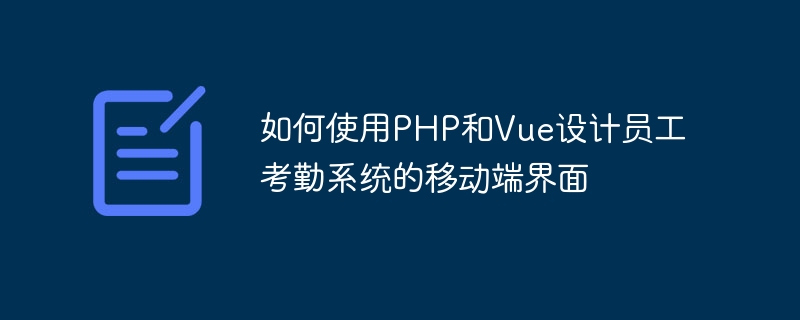Home >Backend Development >PHP Tutorial >How to use PHP and Vue to design the mobile interface of the employee attendance system
How to use PHP and Vue to design the mobile interface of the employee attendance system
- 王林Original
- 2023-09-25 09:03:411538browse

How to use PHP and Vue to design the mobile interface of the employee attendance system
With the rapid development of the mobile Internet, the design of the mobile interface of the employee attendance system has become increasingly important. It's important. PHP and Vue are two commonly used development tools. Their combination can help us easily design powerful and user-friendly mobile interfaces. This article will introduce how to use PHP and Vue to design the mobile interface of the employee attendance system, and provide specific code examples.
1. Preparation
Before you start, please make sure you have installed the development environment of PHP and Vue. If you haven't installed it yet, you can install it according to the official documentation.
2. Build the basic framework
First, we need to create a basic HTML framework and introduce Vue’s CDN link and our custom CSS and JavaScript files.
<!DOCTYPE html>
<html>
<head>
<meta charset="UTF-8">
<title>员工考勤系统</title>
<link rel="stylesheet" href="style.css">
</head>
<body>
<div id="app">
<!-- Your app content here -->
</div>
<script src="https://cdn.jsdelivr.net/npm/vue"></script>
<script src="app.js"></script>
</body>
</html>3. Design the mobile interface
Next, we can start designing the mobile interface. First, create a Vue instance and define a data object in it to store data on the interface.
var app = new Vue({
el: '#app',
data: {
employees: []
}
});Then, we can use Vue’s directives and template syntax to build the interface.
First, we can use the v-for directive to traverse the employee list and display the information of each employee.
<ul>
<li v-for="employee in employees">{{ employee.name }}</li>
</ul>Next, we can use the v-model directive to bind a text input box and assign the entered value to the specified data variable.
<input type="text" v-model="newEmployeeName"> <button @click="addEmployee">添加员工</button>
In the Vue instance, we need to add related methods to handle user operations. For example, we can add an addEmployee method to add a new employee to the list.
var app = new Vue({
el: '#app',
data: {
employees: [],
newEmployeeName: ''
},
methods: {
addEmployee: function() {
this.employees.push({ name: this.newEmployeeName });
this.newEmployeeName = '';
}
}
});4. Interaction with the backend
In the employee attendance system, we usually need to interact with the backend for data. PHP is a powerful back-end language that can help us handle data operations.
First, we need to create a PHP file to receive the request sent by the front end and return the corresponding data.
<?php
// 获取所有员工的信息
function getAllEmployees() {
// 在这里编写查询数据库的代码
return json_encode($employees);
}
// 添加新员工
function addEmployee($name) {
// 在这里编写插入数据库的代码
}
// 根据员工ID删除员工
function deleteEmployee($employeeId) {
// 在这里编写删除数据库中员工的代码
}
// 根据员工ID更新员工信息
function updateEmployee($employeeId, $newName) {
// 在这里编写更新数据库中员工信息的代码
}
// 根据员工ID获取单个员工信息
function getEmployeeById($employeeId) {
// 在这里编写查询数据库的代码
return json_encode($employee);
}
// 处理前端发送的请求
if ($_SERVER['REQUEST_METHOD'] === 'GET') {
echo getAllEmployees();
} elseif ($_SERVER['REQUEST_METHOD'] === 'POST') {
$data = json_decode(file_get_contents("php://input"), true);
addEmployee($data['name']);
} elseif ($_SERVER['REQUEST_METHOD'] === 'DELETE') {
deleteEmployee($_GET['id']);
} elseif ($_SERVER['REQUEST_METHOD'] === 'PUT') {
$data = json_decode(file_get_contents("php://input"), true);
updateEmployee($_GET['id'], $data['name']);
}
?>Next, in the Vue instance on the front end, we can use Vue's life cycle hook function to request data from the back end and update the interface.
var app = new Vue({
el: '#app',
data: {
employees: [],
newEmployeeName: ''
},
created: function() {
this.fetchData();
},
methods: {
fetchData: function() {
fetch('/api/employees')
.then(response => response.json())
.then(data => {
this.employees = data;
});
},
addEmployee: function() {
fetch('/api/employees', {
method: 'POST',
headers: {
'Content-Type': 'application/json',
},
body: JSON.stringify({ name: this.newEmployeeName })
})
.then(response => response.json())
.then(data => {
this.employees.push(data);
this.newEmployeeName = '';
});
}
}
});So far, we have completed designing the mobile interface of the employee attendance system using PHP and Vue. You can further improve and optimize the interface and function code according to your actual needs.
Summary
This article introduces how to use PHP and Vue to design the mobile interface of the employee attendance system, and provides specific code examples. I hope this content can help you design your mobile interface. If you have any questions or confusion, please feel free to ask us for help. Good luck designing a powerful and user-friendly employee attendance system!
The above is the detailed content of How to use PHP and Vue to design the mobile interface of the employee attendance system. For more information, please follow other related articles on the PHP Chinese website!

